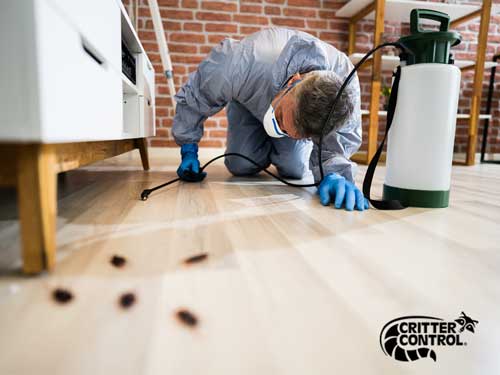Bed Insect Treatment Breakdown: Contrasting Chemical Vs. Non-Chemical Solutions
In the realm of insect control, particularly when taking care of the consistent issue of bed bugs, the choice in between chemical and non-chemical therapy options can be an essential one. Both strategies supply distinctive advantages and drawbacks, influencing aspects such as effectiveness, security considerations, and overall cost. By taking a look at the nuanced details of each method, a clearer understanding of which path to seek in dealing with a bed insect invasion can be acquired.
Effectiveness of Chemical Therapies
Chemical therapies for bed insect problems have actually been commonly identified for their powerful and rapid efficacy in eliminating these pests. When taking into consideration the efficiency of chemical therapies, it is vital to understand that they can supply a extensive and quick remedy to a bed insect problem.
In addition, chemical therapies have the advantage of supplying residual effects, meaning that they can proceed to eliminate bed pests even after the first application. This residual action is specifically valuable in combating any kind of possible re-infestations. Furthermore, the quick activity of chemical therapies can bring relief to individuals dealing with extreme bed pest problems, enabling them to gain back control of their space rapidly.
Safety Interest In Chemical Solutions
When using chemical services for bed insect treatment is guaranteeing the safety and security of occupants and the setting,One critical facet that needs careful consideration. While chemical treatments can be efficient in eradicating bed insects, they might pose risks if not taken care of appropriately. Among the key safety and security interest in chemical options is the prospective harm they can cause to human wellness. Exposure to specific chemicals used in bed bug therapies can bring about respiratory system concerns, skin irritability, or various other negative responses, particularly in people with pre-existing conditions or level of sensitivities. In addition, inappropriate application or dosage of chemical pesticides can result in hazardous deposits sticking around in the cured location, presenting long-lasting health and wellness risks to residents.
In addition, the environmental influence of chemical remedies is another considerable consideration. Some chemicals used in bed insect treatments might be unsafe to beneficial insects, wild animals, and ecological communities if they seep into the soil or water systems. It is important to use chemical therapies judiciously, following security standards, and thinking about much less hazardous options to mitigate these dangers and ensure the effective and secure management of bed insect infestations.
Benefits of Non-Chemical Strategies
Taking into consideration the potential safety and security concerns and ecological impact connected with chemical services for bed pest treatment, exploring non-chemical approaches offers a promising choice with a number of distinct advantages. Non-chemical techniques offer a safer alternative for families, particularly those with people, youngsters, or family pets delicate to harsh chemicals. These techniques remove the threats of direct exposure to harmful materials, reducing the capacity for negative health and wellness results. In addition, non-chemical treatments are eco-friendly, as they do not add to air or water contamination, making them a sustainable option for insect control.
In addition, non-chemical services can be efficient in targeting bed pests, consisting of hard-to-reach areas where chemical therapies may not penetrate - A1 charlotte pest control companies. Approaches such as warmth therapy, vacuuming, heavy steam cleaning, and cushion coverings insect exterminator offer detailed removal without the use of damaging chemicals.
Limitations of Non-Chemical Treatments

Furthermore, non-chemical treatments frequently call for multiple applications to attain successful elimination. This can be time-consuming and might not always assure complete removal of all bed pests and their eggs, especially in surprise or hard-to-reach places.
In addition, the success of non-chemical therapies greatly relies upon proper implementation and thoroughness, which can be challenging for people without expert know-how. Insufficient application of non-chemical techniques might cause insufficient eradication, resulting in persistent infestations and the need for extra treatments.
For that reason, while non-chemical therapies have their advantages, it is necessary to acknowledge these limitations and consider them when establishing the most efficient technique for handling bed insect infestations.
Price Comparison: Chemical Vs. Non-Chemical Options
Provided the limitations related pest insurance to non-chemical treatments, a vital facet to evaluate in the context of bed insect management is the cost contrast in between chemical and non-chemical alternatives. Chemical therapies typically involve the application of pesticides by specialists, which can vary from $250 to $900 per area, relying on the extent of the problem and the size of the area to be treated. On the other hand, non-chemical therapies like warm treatment or steam can be much more expensive, with costs varying from $1,000 to $6,000 for a whole home. While the initial cost of chemical treatments may seem lower, several therapies might be needed to completely get rid of the infestation, possibly boosting the general expense. On the various other hand, non-chemical alternatives may provide a more environment-friendly and lasting solution, although they can be cost-prohibitive for some individuals. Ultimately, when taking into consideration the cost of bed insect therapy choices, it is essential to evaluate the upfront expenses against the effectiveness and long-term sustainability of the chosen approach.
Verdict

Considering the possible safety concerns and environmental impact linked with chemical services for bed pest therapy, checking out non-chemical strategies presents a promising alternative with a number of unique advantages.Provided the limitations associated with non-chemical therapies, an important aspect to assess in the context of bed insect monitoring is the cost contrast in between chemical and non-chemical options. Get More Information In comparison, non-chemical treatments like warm therapy or steam can be extra pricey, with expenses ranging from $1,000 to $6,000 for an entire home. While the initial price of chemical treatments may seem reduced, several therapies might be required to completely get rid of the invasion, possibly enhancing the overall expense.In conclusion, when contrasting chemical and non-chemical bed bug treatment alternatives, it is essential to take into consideration efficiency, safety, advantages, constraints, and cost.
Comments on “Trusted A1 Bed Bug Exterminator Charlotte - Get Rid of Bed Bugs Fast”